Once, the Fossil Record was Thought to Prove Evolution
Paleontology, the study of fossils, developed long before Darwin. The founder of this science was the French naturalist, Baron Georges Cuvier (1769-1832). According to the Encyclopedia Britannica, he introduced fossils into zoological classification, showed the progressive relation between rock strata and their fossil remains, and demonstrated, in his comparative anatomy and reconstructions of fossil skeletons, the importance of functional and anatomical relationships.18
Cuvier was opposed to the theory of evolution proposed in his time by Lamarck. He insisted that genera of living things were created separately, stressed the detail and delicacy in animal anatomy and explained that its characteristics ruled out any idea of random alteration. Cuvier also argued that "each species is so well coordinated, functionally and structurally, that it could not survive significant change. He further maintained that each species was created for its own special purpose and each organ for its special function."19
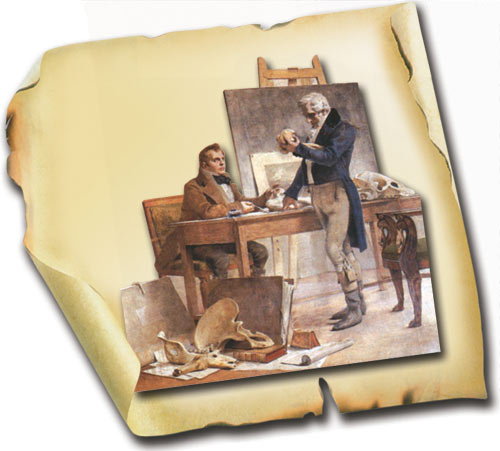 |
| Cuvier, the founder of paleontology, maintained that creation is a scientific fact and that evolution is impossible. |
But Charles Darwin interpreted fossils differently. He believed that various species descended in stages from a single, common ancestor in a process of evolution and that fossils were proof of this process.
But Darwin's interpretation rests on no proof. On the contrary, in his day, no extant fossils demonstrated evolution. The fossil remains of extinct creatures did not share the kind of family relationship and resemblance that Darwin's theory required. Every known fossil, like every known living thing, possessed its own unique features. As is the case with natural history today, species of the past have not been very similar and close to one another, but rather divided into groups that are very different from one another, with major structural differences between them.
For this reason, Darwin could not use fossils to prove his theory. On the contrary, his book proposed "fabricated explanations" to misrepresent this matter that posed such a serious problem for him. He dealt with this matter in the chapter entitled "Difficulties on Theory" and appended to the book another chapter titled "On the Imperfection of the Geological Record," that dealt with the absence of intermediate fossil forms.
But in both these chapters, Darwin's problem could be seen clearly. His theory was based on the claim that species came into being by a long series of incremental changes. If it were so, intermediate forms must have existed to link one species to another; but no trace of such creatures has been found in the fossil record.
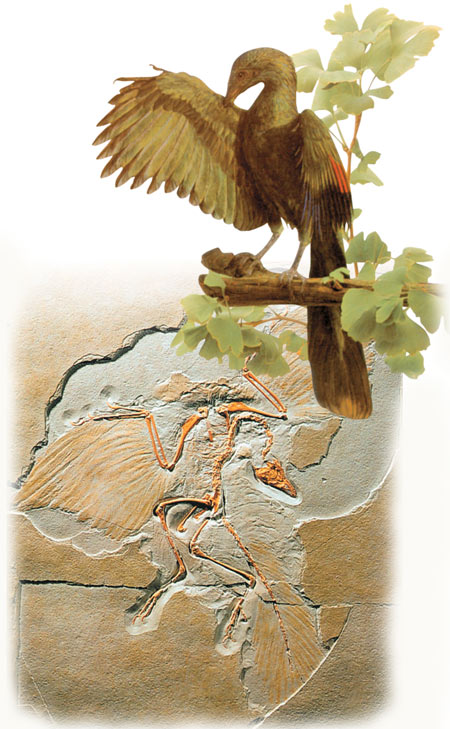 |
| Contrary to what evolutionists claim, it is now known that Archaeopteryx was not a "primitive bird" but possessed a flawless flying ability. |
Darwin was finally forced to leave this problem for future researchers. He thought the problem lay in the insufficiency of the fossil record; he was certain that, as new fossils were unearthed, specimens would come to light to prove his theory. He wrote:
Geology assuredly does not reveal any such finely-graduated organic chain; and this, perhaps, is the most obvious and serious objection which can be urged against the theory. The explanation lies, as I believe, in the extreme imperfection of the geological record. 20
Darwin's prediction persuaded a growing number to carry out excavations in search of the supposed "lost" intermediate forms to extend the fossil record. They made some exciting finds, but over time, it was realized that their excitement was unfounded.
One of these "breakthroughs," discovered in 1860 near the German town of Solnhofen, was the fossil to which they gave the name Archaeopteryx, the Greek for "ancient wing." Despite the fact that it was clearly a bird, it had some peculiar features which were considered reptilian: teeth, a long tail and claws on its wings. This gave Darwinists a rare opportunity. One of Darwin's most avid defenders, Thomas Huxley, announced that Archaeopteryx was half-bird and half-reptile. The assumption that its wings weren't suitable for flying led to the conclusion that it was a primitive bird; this generated a lot of popular excitement and thus was born the Archaeopteryx myth that was to hold sway throughout the 20th century.
In time, it was realized that this creature was not a primitive bird; in fact, its skeleton and feather structure made it well adapted to flying. Its reptile-like features were also possessed by some birds of the past and of today.
As a result of these discoveries, evolutionist speculations about Archaeopteryx as the best candidate for an intermediate form are largely silenced today. Alan Feduccia, an expert ornithologist and professor from the Biology Department of the University of North Carolina, said that "most recent workers who have studied various anatomical features of Archaeopteryx have found the creature to be much more birdlike than previously imagined." Again according to Feduccia, "the resemblance of Archaeopteryx to theropod dinosaurs has been grossly overestimated."21 In short, it is now known that there is no vast difference between Archaeopteryx and other birds.
 |
| Thomas Huxley, Darwin's most fervent supporter |
In the century and a half since Darwin, no intermediate forms—including Archaeopteryx—have been found. This fact has become undisputable, especially since the 1970s but it is still ignored by a few paleontologists who espouse the theory of evolution. Among these paleontologists, the best known are Stephen J. Gould and Niles Eldridge. These two have proposed a different model of evolution under the name of "punctuated equilibrium," in which they insist that the fossil record has refuted Darwinism's "gradualism." They have shown in detail that various genera of living things appeared suddenly in the fossil record and remained unchanged for hundreds of millions of years.
In a book written with Ian Tattersall, another evolutionist paleontologist, Eldredge made this important assessment:
That individual kinds of fossils remain recognizably the same throughout the length of their occurrence in the fossil record had been known to paleontologists long before Darwin published his Origin. Darwin himself ...prophesied that future generations of paleontologists would fill in these gaps by diligent search...One hundred and twenty years of paleontological research later, it has become abundantly clear that the fossil record will not confirm this part of Darwin's predictions. Nor is the problem a miserably poor record. The fossil record simply shows that this prediction is wrong.
The observation that species are amazingly conservative and static entities throughout long periods of time has all the qualities of the emperor's new clothes: everyone knew it but preferred to ignore it. Paleontologists, faced with a recalcitrant record obstinately refusing to yield Darwin's predicted pattern, simply looked the other way.22
In a book written jointly in 1988 entitled Integrated Principles of Biology, three evolutionist biologists developed the same point:
Many species remain virtually unchanged for millions of years, then suddenly disappear to be replaced by a quite different ...form. Moreover, most major groups of animals appear abruptly in the fossil record, fully formed, and with no fossils yet discovered that form a transition from their parent group.23
New discoveries have not changed the situation in favor of Darwinism; on the contrary, they've made it worse. In 1999 Tom Kemp, curator of the zoological collections of the Oxford University, wrote a book entitled, Fossils and Evolution in which he described the situation:
 |
| A pictorial reconstruction of Archaeopteryx |
In virtually all cases, a new taxon appears for the first time in the fossil record with most definitive features already present, and practically no known stem-group forms.24
So, the fossil record which was once thought to corroborate Darwin's theory has become evidence against it. David Berlinsky, a mathematician from the Princeton University and an opponent of evolution, sums up the situation:
There are gaps in the fossil graveyard, places where there should be intermediate forms, but where there is nothing whatsoever instead. No paleontologist writing in English, French or German denies that this is so. It is simply a fact. Darwin's theory and the fossil record are in conflict.25
One of the most striking examples of this contradiction is the collapse of Darwin's "tree of life."
Once, There was Thought to be an "Evolution Tree"
 |
| Charles D. Walcott |
The most punishing blow that the fossil record dealt Darwinism was the scenario revealed by the fossils from the Cambrian period. Darwin imagined that the history of life on Earth could be represented as a tree starting from one trunk and slowly, gradually separating into various branches. A diagram in The Origin of the Species reflected this view. With the aid of this chart, the concept of the evolutionary "tree" was planted in people's minds, to finally become one of Darwinism's most important myths. Various versions of the evolutionary tree were published in textbooks, scientific treatises, magazines and newspapers. These diagrams etched in people's minds the idea that living things evolved by small chance changes from one common root of the evolutionary tree.
The truth was quite different, however. This was most clearly dramatized with the discovery of the Cambrian explosion at the beginning of the 20th century. In the year 1909, the paleontologist Charles D. Walcott began investigations in the Canadian Rocky Mountains. In the area of the Burgess Pass, he discovered very well-preserved strata of shale rock. He quickly realized that the Burgess Shale contained many fossils belonging to the Cambrian period. For the next four years, Walcott carefully collected between 60,000 and 80,000 fossils from the shale and made a note of the most subtle differences he discovered among them.
The most amazing thing about the Burgess Shale fossils was that they contained the remains of creatures belonging to all the phyla alive today. (A phylumis the largest taxonomic category used to classify creatures in the animal kingdom. Animals are divided into more than 50 phyla, and each phylum has its own body design. Among the best known phyla are the Chordata including the vertebrates, the Arthropoda containing all insects, and Mollusca containing all soft-bodied invertebrates with shells.)
Walcott was very surprised to see what phyla these fossils belonged to. No significant life had been discovered in much older strata; but the layer he discovered contained creatures belonging to nearly all known phyla, and fossils of hitherto unknown phyla as well. This showed that all the bodily characteristics in the animal kingdom came about at the same time, in the same geological period.
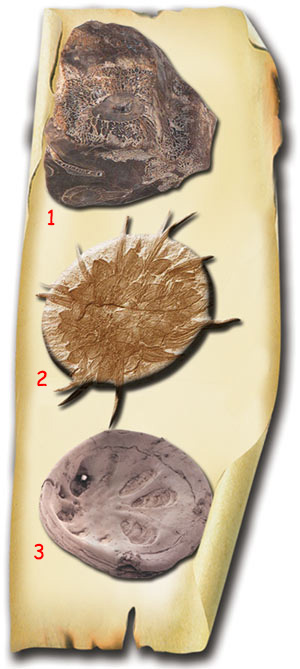 |
| 1. A Metaldetes fossil resembling present-day sponges 2. A fossil Wiwaxia, frequently encountered in strata from the Cambrian period 3. Mobergella: |
| Fossils from the Cambrian period (545 to 495 million years ago) show that living things appear in geological strata with all their complex characteristics, without having first undergone a process of evolution—in other words that they were created. |
This dealt a fatal blow to Darwin's theory. He had proposed that creatures had developed slowly and gradually, like the twigs of a tree. According to Darwin's speculations, at first there must have been one single phylum in the world, and different phyla developed slowly, over the course of time. Now, however, this theory had to contend with Walcott's proof that all phyla came into being suddenly, at the same time.
But it would be 70 years before this blow turned the theory of the evolutionary tree upside down, because Walcott, at the end of four years of meticulous study, decided to keep his fossils a secret instead of revealing them to the scientific world. He was the Secretary of the Smithsonian Institution in Washington D.C. and a staunch Darwinist. Thinking—correctly—that the fossils he had discovered would pose a major problem for the theory of evolution, he kept them in the museum's archives rather than releasing them. The Burgess Shale fossils came to light only during an examination of the museum's archives in 1985. The Israeli scientist Gerald Schroeder makes the following comment:
Had Walcott wanted, he could have hired a phalanx of graduate students to work on the fossils. But he chose not to rock the boat of evolution. Today fossil representatives of the Cambrian era have been found in China, Africa, the British Isles, Sweden, Greenland. The explosion was worldwide. But before it became proper to discuss the extraordinary nature of the explosion, the data were simply not reported. 26
For more than 70 years, these fossils had remained hidden until they were found and analyzed by paleontologists Harry Whittington, Derek Briggs and Simon Conway Morris. These three scientists revealed that the fossils Walcott had found dated back to the Cambrian period, one of the oldest geological periods. The sudden appearance of such a wide variety of creatures during this period was termed the Cambrian explosion. In the 1980s, two new areas of fossil remains similar to the Burgess Shale fossils were discovered: one in Sirius Passet in northern Greenland, and the other in Chengjiang in southern China. In both these areas were found fossils of very different creatures that came into being during the Cambrian period. Among these the oldest and best preserved fossils were those found in Chenjiang, which also contained the first vertebrates. In addition, two 530-million-year-old fish fossils discovered in 1999 proved that all body structures, including the vertebrates, were already in existence during the Cambrian. Investigations showed that the Cambrian explosion occurred within a 10-million-year period, which in geological terms is quite a short time. And the creatures that suddenly appeared in this period all had very complicated organs and had no resemblance with the one-celled and a few multi-celled organisms that preceded them. Stephen J. Gould describes the Cambrian explosion as follows:
The most famous such burst, the Cambrian explosion, marks the inception of modern multicellular life. Within just a few million years, nearly every major kind of animal anatomy appears in the fossil record for the first time.27
Evolutionists have tried to explain away the Cambrian explosion in various ways, none of them convincing. All the theses put forward against the Cambrian problem are flawed, which is demonstrated by the arguments that evolutionists have among themselves. The February 1999 edition of the noted science magazine Trends in Genetics (TIG) says that the Burgess Shale fossil finds cannot at all be explained in terms of the theory of evolution, and that the theses proposed are not convincing:
It might seem odd that fossils from one small locality, no matter how exciting, should lie at the center of a fierce debate about such broad issues in evolutionary biology. The reason is that animals burst into the fossil record in astonishing profusion during the Cambrian, seemingly from nowhere. Increasingly precise radiometric dating and new fossil discoveries have only sharpened the suddenness and scope of this biological revolution. The magnitude of this change in Earth's biota demands an explanation. Although many hypotheses have been proposed, the general consensus is that none is wholly convincing.28
 |
| A. IMAGINARY |
| 1. Marella: 2. Xystridura: 3. Pikaia: |
| The fact that all living phyla existed during the Cambrian period demolishes the basis of the Darwinist family tree. |
In Icons of Evolution, the American biologist Jonathan Wells sums up the matter in these words:
Of all the icons of evolution, the tree of life is the most pervasive, because descent from a common ancestor is the foundation of Darwin's theory...Yet Darwin knew—and scientists have recently confirmed—that the early fossil record turns the evolutionary tree of life upside down. Ten years ago it was hoped that molecular evidence might save the tree, but recent discoveries have dashed that hope. Although you would not learn it from reading biology textbooks, Darwin's tree of life has been uprooted.29
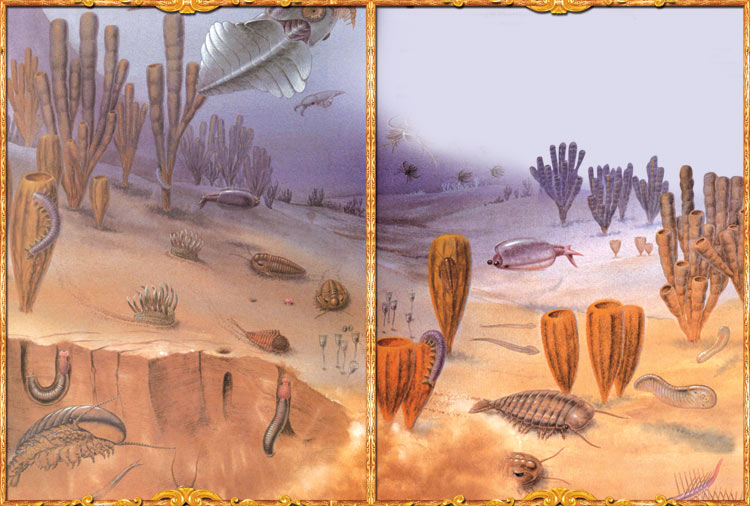 |
| An illustration of the complex creatures that appeared suddenly during the Cambrian period. |
For this reason, we can safely say that once upon a time, there was a theory called Darwinism, which some people thought was supported by fossils. But the fossil record indicates just the opposite. Now, Darwinism is no more. Fossils—as we now understand—show that life appeared on Earth suddenly, not by evolution.
This sudden appearance implies Creation. God has created all living things perfectly from nothing.
[God is] the Originator of the heavens and Earth. When He decides on something, He just says to it, "Be!" and it is. (Surat al-Baqara: 117)
Fossils of Complex Living Things that Existed Hundreds of Millions of Years Ago Refute Evolutionist .
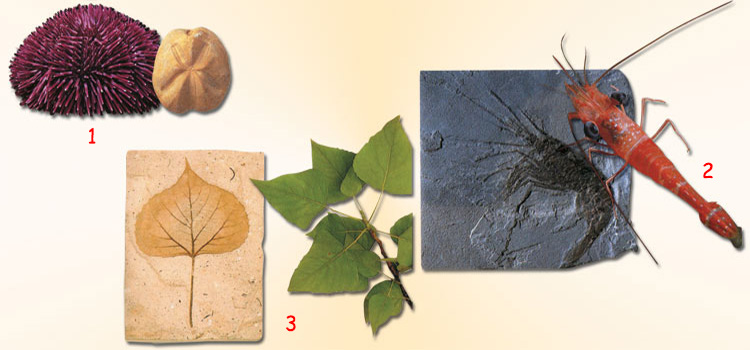 |
| 1. A fossil sea urchin from the Ordovician period (490 to 443 million years ago), and a modern-day specimen. 2. A fossil shrimp from the Jurassic period (206 to 144 million years ago) has the same structure as present-day specimens. 3. A 25-million-year old poplar leaf is no different than modern-day poplar leaves. |
| One important result revealed by the fossil record is "stasis." There is no difference between fossils that lived hundreds of millions of years ago and living specimens. No "evolution" ever took place. |
 |
| 1. This fossil shark from the Carboniferous period (354 to 292 million years ago) indicates that the shark existed in its present-day form millions of years ago. 2. This fossilized ginkgo tree leaf from the Triassic period (251 to 205 million years ago) is identical to modern-day ginkgo leaves. This and many other similar fossil specimens totally undermine the claim that living things evolved from one another. 3. The dragonfly, a subject of research by modern-day scientists into flight techniques, reveals its perfect appearance and characteristics in this 140-million-year-old specimen. 4. Above: A maple leaf of the Miocene epoch (23.8 to 5.32 million years ago) and a modern-day specimen 5. Above: A winged maple seed fossil from the Oligocene epoch (33.7 to 23.8 million years ago) 6. Right: A Miocene epoch fossil flower |
Footnotes
18- Encyclopedia Britannica 2002, Expanded Edition DVD-ROM, "Cuvier, Georges, Baron"
19- Encyclopedia Britannica 2002, Expanded Edition DVD-ROM, "Cuvier, Georges, Baron"
20- Charles Darwin, The Origin of Species by Means of Natural Selection, The Modern Library, New York, s. 234
21- Alan Feduccia, The Origin and Evolution of Birds, Yale University Press, 1999, s. 81
22- N. Eldredge, and I. Tattersall, The Myths of Human Evolution, Columbia University Press, 1982, s. 45-46
23- Hickman, C.P. [Professor Emeritus of Biology at Washington and Lee University in Lexington], L.S. Roberts [Professor Emeritus of Biology at Texas Tech University], and F.M. Hickman. 1988. Integrated Principles of Zoology. Times Mirror/Moseby College Publishing, St. Louis, MO. 939; (s. 866)
24- Fossils and Evolution, Dr TS Kemp - Curator of Zoological Collections, Oxford University, Oxford Uni Press, s.246, 1999
25- David Berlinksi, Commentary , Sept. 1996 s. 28
26- Gerald Schroeder, "Evolution: Rationality vs. Randomness", http://www.geraldschroeder.com/evolution.html
27- Stephen J. Gould, “An Asteroid to Die For,” Discover, Ekim 1989, s. 65
28- Gregory A. Wray, "The Grand Scheme of Life", Review of The Crucible Creation: The Burgess Shale and the Rise of Animals by Simon Conway Morris, Trends in Genetics, February 1999, vol. 15, no. 2
29- Jonathan Wells, Icons of Evolution, s. 31
- Introduction
- Darwinism's Crumbling Myths and the Correct Definition of Science
- Once, Life was Thought to be Simple
- Once, the Fossil Record was Thought to Prove Evolution
- Once, There was a Search for the Missing Link
- Once, There was no Knowledge of Biological Information
- Once, It was Believed that There was "Embryological Evidence for Evolution"
- Once, There was the Myth of Faulty Characteristics
- Once, There was the Myth of "Junk" DNA
- Once, the Origin of Species was Thought to Lie in
- Once, There was the "Horse Series" Scenario
- Once, There was the Story of Peppered Moths
- Until Recently, There were Stories of the Dino-Bird
- Conclusion
